Enhancing CO2 Sweep Efficiency in Tight Reservoir Horizontal Wells: A Segmented Huff-and-Puff Strategy to Mitigate Heterogeneity Effects
Abstract
1. Introduction
2. Segmented CO2 Huff-and-Puff Strategy for Horizontal Wells in Tight Reservoirs
2.1. Proposal of the Segmented Huff-and-Puff Concept
2.2. Design of Segmented Huff-and-Puff Scheme and Parameter Settings
- (1)
- Toe–Middle–Heel: CO2 is first injected into the toe section, then the middle section, and finally the heel section.
- (2)
- Heel–Middle–Toe: CO2 is first injected into the heel section, followed by the middle, and finally the toe section.
2.3. Introduction to the Simulation Model
3. Results and Discussion
3.1. Comparison of Segmental vs. Overall Huff-and-Puff Effectiveness
3.2. Influence of Segmental Huff-and-Puff Sequence
3.3. Impact of Injection Rate on Segmented Huff-and-Puff Performance
4. Conclusions
- (1)
- Compared with conventional huff-and-puff operations, segmented CO2 huff-and-puff in tight shale oil reservoirs can effectively mobilize the remaining oil in low-permeability zones and achieve efficient displacement even with a horizontal well length of 2000 m, thereby mitigating the adverse effects of reservoir heterogeneity.
- (2)
- The sequence of segmented huff-and-puff operations has a noticeable influence on horizontal well performance. Initiating CO2 injection from the toe section and proceeding successively toward the heel can drive the remaining oil from the distal end toward the near-well region, enhancing the utilization of residual oil in the far end. Compared with the heel–middle–toe sequence, this toe–middle–heel sequence reduces the water cut by 0.13% and increases the recovery factor by 0.07%, achieving the dual effect of water reduction and oil enhancement.
- (3)
- High-rate CO2 injection significantly expands the sweep volume and enhances CO2–oil interactions, thereby improving oil recovery from the deeper sections of the horizontal well. Under high-rate huff-and-puff conditions, the recovery factor increases by 7.13% compared with the low-rate injection, demonstrating enhanced flow capacity in low-permeability reservoir zones and improved mobilization of residual oil in tight streaks.
- (4)
- This study proposes, from a numerical simulation perspective, a feasible method for enhancing oil recovery through CO2 huff-and-puff in tight reservoirs. Experimental validation has not yet been conducted. Moreover, large-scale segmented CO2 huff-and-puff operations with different injection sequences impose higher technical requirements on field equipment; therefore, future research should focus on the development of supporting tools and technologies.
Author Contributions
Funding
Data Availability Statement
Acknowledgments
Conflicts of Interest
References
- Chen, Z.; Li, R.; Yang, S.; Qin, Y.; Gong, L.; Zhang, D. A novel algorithm for asphaltene precipitation modeling in shale reservoirs with the consideration of capillary pressure during the CCUS processes. Appl. Therm. Eng. 2024, 248 Pt A, 123217. [Google Scholar] [CrossRef]
- Guo, Y.N.; Feng, R.; Lei, Q.; Chen, Y. Advances and prospects in efficient development technologies for tight sandstone reservoirs. Petrochem. Ind. Technol. 2025, 32, 231–233. [Google Scholar]
- Hu, Y.L.; Hao, M.Q.; Chen, G.L.; Sun, R.; Li, S. Technologies and practice of CO2 flooding and sequestration in China. Pet. Explor. Dev. 2019, 46, 716–727. [Google Scholar] [CrossRef]
- Ma, J.H.; Wang, X.Z.; Gao, R.M.; Zeng, F.H.; Huang, C.X.; Tontiwachwuthikul, P.P.; Liang, Z.W. Enhanced light oil recovery from tight formations through CO2 huff-n-puff processes. Fuel 2015, 154, 35–44. [Google Scholar] [CrossRef]
- Zhang, D.P. CO2 flooding enhanced oil recovery technique and its application status. Sci. Technol. Rev. 2011, 29, 75–79. [Google Scholar]
- Zhang, Y.H.; Sheng, J.P.; Li, Q.X.; Song, P.; Chen, Y.K.; Tan, J.H. Advances in the application of CO2 stimulation technology. Spec. Oil Gas Reserv. 2021, 28, 1–10. [Google Scholar]
- Zhou, T.; Liu, X.W.; Wang, Y.L.; Qin, C.G.; Gai, C.C. Experiment of CO2 huff-n puff process in staged fracturing horizontal wells for developing tight oil reservoirs. J. Southwest Pet. Univ. Sci. Technol. Ed. 2017, 39, 125–131. [Google Scholar]
- Halinda, D.; Zariat, A.A.; Muraza, O.; Marteighianti, M.; Setyawan, W.; Haribowo, A.; Rajab, M.; Firmansyah, M.; Hasan, I.; Nurlia, D.; et al. CO2 huff and puff injection operation overview in Jatibarang field lessons learned from a successful case study in mature oil field. In Proceedings of the ADIPEC, Abu Dhabi, United Arab Emirates, 2–5 October 2023. [Google Scholar] [CrossRef]
- Huang, X.; Li, X.; Zhang, Y.; Li, T.; Zhang, R. Microscopic production characteristics of crude oil in nano-pores of shale oil reservoirs during CO2 huff and puff. Pet. Explor. Dev. 2022, 49, 557–564. [Google Scholar] [CrossRef]
- Lang, D.; Lun, Z.; Lyu, C.; Wang, H.; Zhao, Q.; Sheng, H. Nuclear magnetic resonance experimental study of CO2 injection to enhance shale oil recovery. Pet. Explor. Dev. 2021, 48, 603–612. [Google Scholar] [CrossRef]
- Zhang, Y.; Yuan, L.; Liu, S.; Zhang, J.; Yang, M.; Song, Y. Molecular dynamics simulation of bubble nucleation and growth during CO2 huff-and-puff process in a CO2-heavy oil system. Geoenergy Sci. Eng. 2023, 227, 211852. [Google Scholar] [CrossRef]
- Jiang, J.S.; Liu, Q.J.; Wang, J.L. Calculation method for effective radius of carbon dioxide huff and puff in tight reservoirs. Sci. Technol. Eng. 2020, 20, 2216–2222. [Google Scholar]
- Ma, Q.Z.; Yang, S.L.; Chen, H.; Wang, L.; Qian, K.; Meng, Z.; Lei, H.; Wang, Z.L. Effect and influencing factors of CO2 huff and puff in a tight oil reservoir—Taking the Lucaogou formation in the Xinjiang Jimsar sag as an example. Pet. Sci. Bull. 2018, 04, 434–445. [Google Scholar]
- Tang, X.; Li, Y.; Han, X.; Zhou, Y.; Zhan, J.; Xu, M.; Zhou, R.; Cui, K.; Chen, X.; Wang, L. Dynamic characteristics and influencing factors of CO2 huff and puff in tight oil reservoirs. Pet. Explor. Dev. 2021, 48, 817–824. [Google Scholar] [CrossRef]
- Abedini, A.; Torabi, F. On the CO2 storage potential of cyclic CO2 injection process for enhanced oil recovery. Fuel 2014, 124, 14–27. [Google Scholar] [CrossRef]
- Hou, G. Practice and understanding of the CO2 huff-puff for the volume fractured horizontal well in tight oil reservoirs. Pet. Geol. Oilfield Dev. Daqing 2018, 37, 163–167. [Google Scholar]
- Liu, G. Optimization of injection and production parameters of CO2 huff and puff by horizontal wells with volume fracturing in tight oil. Pet. Geol. Eng. 2020, 34, 90–93. [Google Scholar]
- Liu, J.; Li, H.; Tan, Q.; Liu, S.; Zhao, H.; Wang, Z. Quantitative study of CO2 huff-and-puff enhanced oil recovery in tight formation using online NMR technology. J. Pet. Sci. Eng. 2022, 216, 110688. [Google Scholar] [CrossRef]
- Abedini, A.; Torabi, F. Oil recovery performance of immiscible and miscible CO2 huff-and-puff processes. Energy Fuels 2014, 28, 774–784. [Google Scholar] [CrossRef]
- Li, L.; Su, Y.; Sheng, J.J.; Hao, Y.; Wang, W.; Lv, Y.; Zhao, Q.; Wang, H. Experimental and numerical study on CO2 sweep volume during CO2 huff-and-puff EOR process in shale oil reservoirs. Energy Fuels 2019, 33, 4017–4032. [Google Scholar] [CrossRef]
- Perera, M.; Gamage, R.; Rathnaweera, T.; Ranathunga, A.; Koay, A.; Choi, X. A review of CO2-enhanced oil recovery with a simulated sensitivity analysis. Energies 2016, 9, 481. [Google Scholar] [CrossRef]
- Talebian, S.H.; Masoudi, R.; Tan, I.M.; Zitha, P.L.J. Foam assisted CO2-EOR: A review of concept, challenges, and future prospects. J. Pet. Sci. Eng. 2014, 120, 202–215. [Google Scholar] [CrossRef]
- Rezaei, F.; Rezaei, A.; Jafari, S.; Hemmati-Sarapardeh, A.; Mohammadi, A.H.; Zendehboudi, S. On the evaluation of interfacial tension (IFT) of CO2-paraffin system for enhanced oil recovery process: Comparison of empirical correlations, soft computing approaches, and parachor model. Energies 2021, 14, 3045. [Google Scholar] [CrossRef]
- Hao, H.; Hou, J.; Qu, M.; Guo, W.; Deng, S.; Liu, H. Using a well-to-well interplay during the CO2 huff-and-puff process for enhanced oil recovery in an inclined oil reservoir: Experiments, simulations, and pilot tests. Front. Energy Res. 2023, 10, 1002053. [Google Scholar] [CrossRef]
- Chen, C.; Balhoff, M.; Mohanty, K.K. Effect of reservoir heterogeneity on primary recovery and CO2 huff-and-puff recovery in shale-oil reservoirs. SPE Reserv. Eval. Eng. 2014, 17, 404–413. [Google Scholar] [CrossRef]
- Orozco, D.; Fragoso, A.; Selvan, K.; Noble, G.; Aguilera, R. Eagle Ford huff-and-puff gas-injection pilot: Comparison of reservoir simulation, material balance, and real performance of the pilot well. SPE Reserv. Eval. Eng. 2020, 23, 247–260. [Google Scholar] [CrossRef]
- Gamadi, T.D.; Elldakli, F.; Sheng, J.J. Compositional simulation evaluation of EOR potential in shale oil reservoirs by cyclic natural gas injection. In Proceedings of the SPE/AAPG/SEG Unconventional Resources Technology Conference, Denver, CO, USA, 25–27 August 2014. [Google Scholar]
- Elturki, M.; Imqam, A. Experimental investigation of asphaltene deposition and its impact on oil recovery in Eagle Ford Shale during miscible and immiscible CO2 huff-n-puff gas injection. Energy Fuels 2023, 37, 2993–3010. [Google Scholar] [CrossRef]
- Chen, H.; Hu, Y.; Kang, Y.; Wang, X.C.; Liu, F.; Liu, Y.W. Advantages of supercritical CO2 compound fracturing in shale on fracture geometry, complexity and width. J. Nat. Gas Sci. Eng. 2021, 93, 104033. [Google Scholar] [CrossRef]
- Moosavi, N.; Bagheri, M.; Nabi-Bidhendi, M. Hydrocarbon reservoir parameter estimation using a fuzzy Gaussian-based SVR method. Bull. Geophys. Oceanogr. 2024, 65, 70. [Google Scholar] [CrossRef]
- Mehrabi, A.; Bagheri, M.; Nabi-Bidhendi, M.; Biniaz Delijani, E.; Behnoud, M. Improved porosity estimation in complex carbonate reservoirs using a hybrid CRNN deep-learning model. Earth Sci. Inform. 2024, 17, 4773–4790. [Google Scholar] [CrossRef]
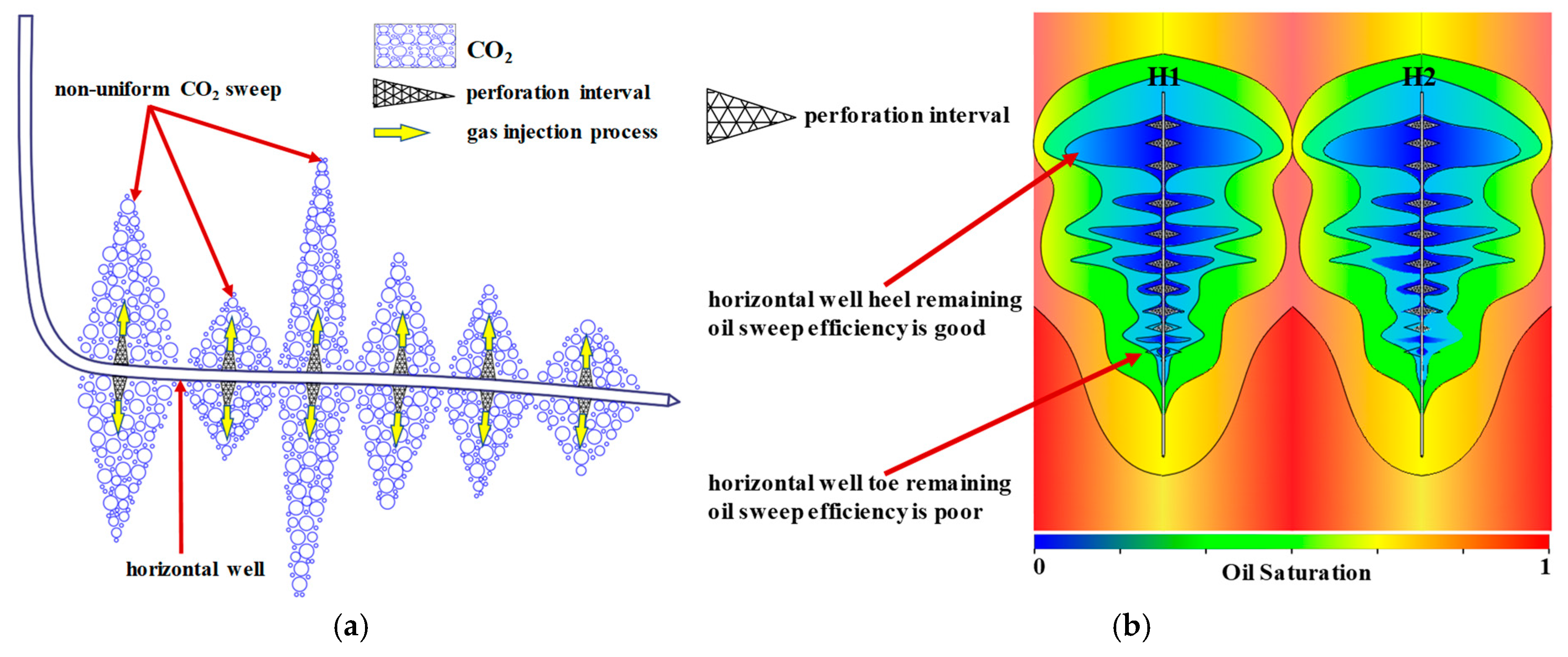
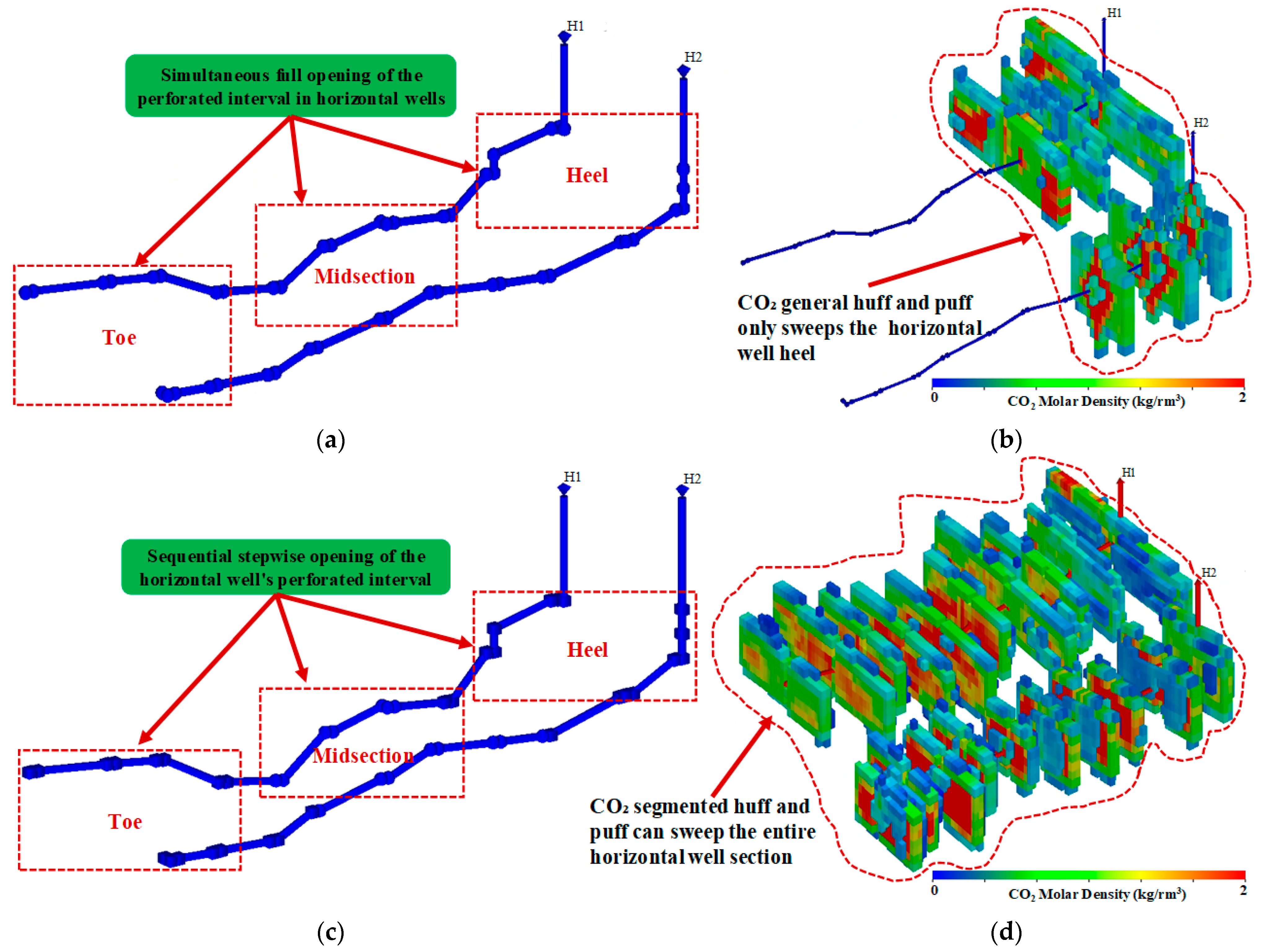

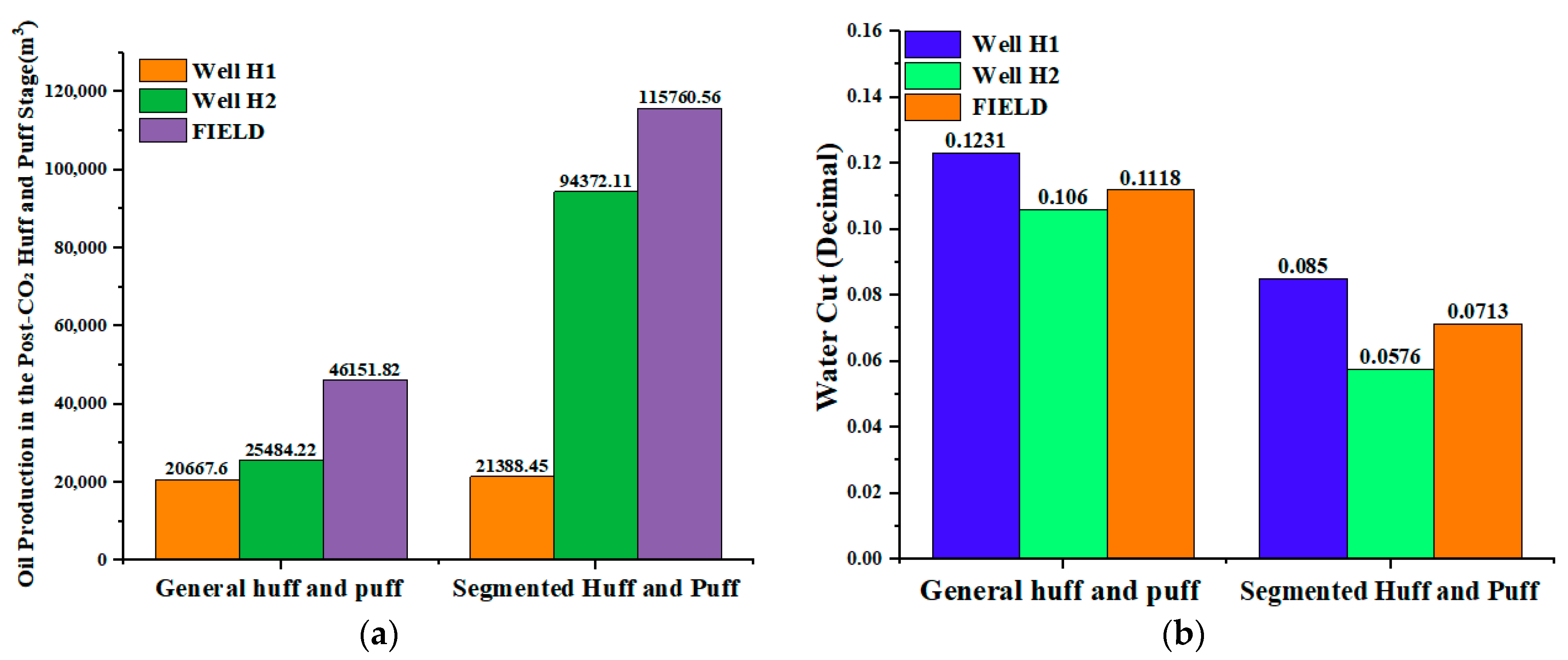
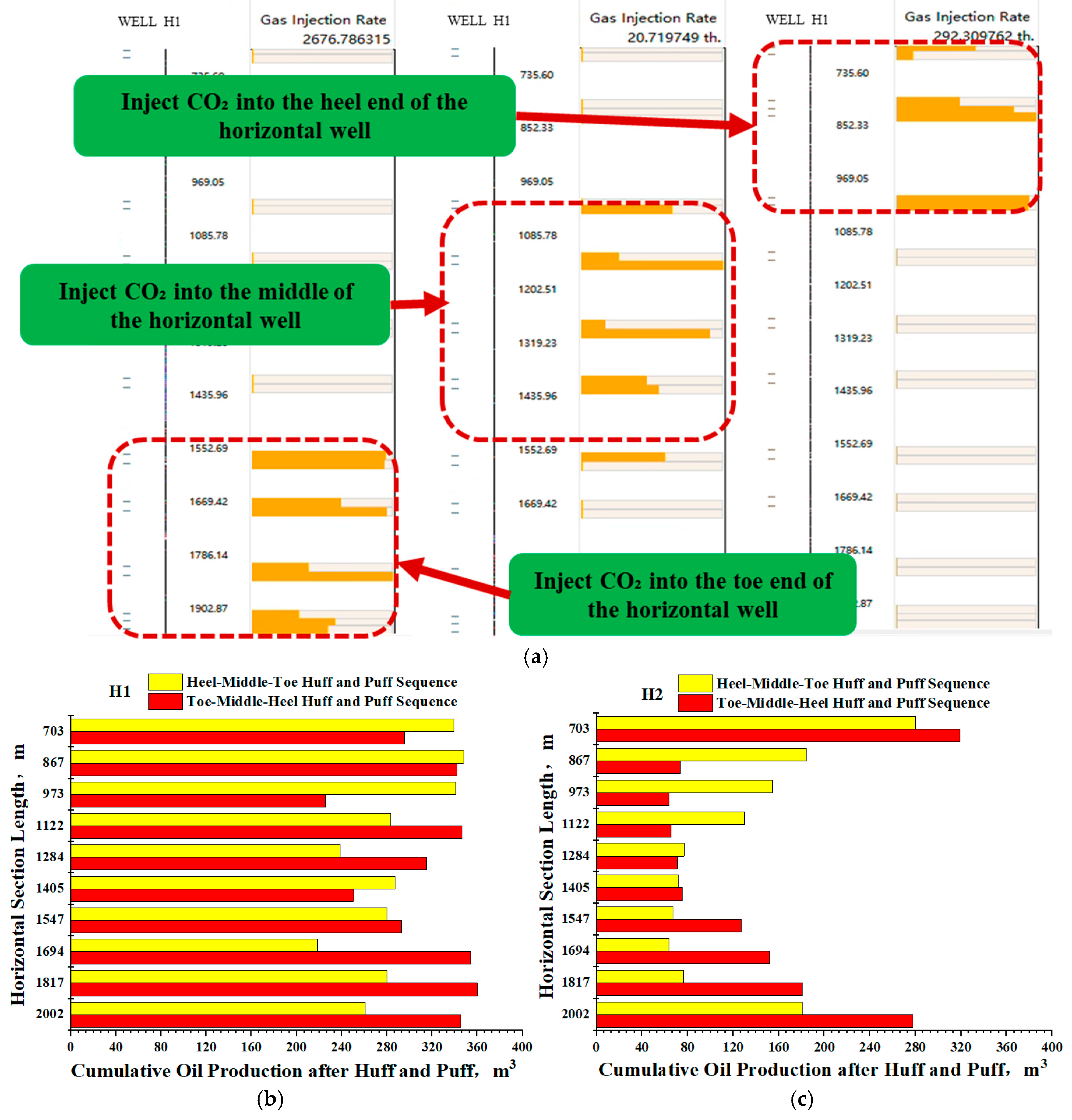
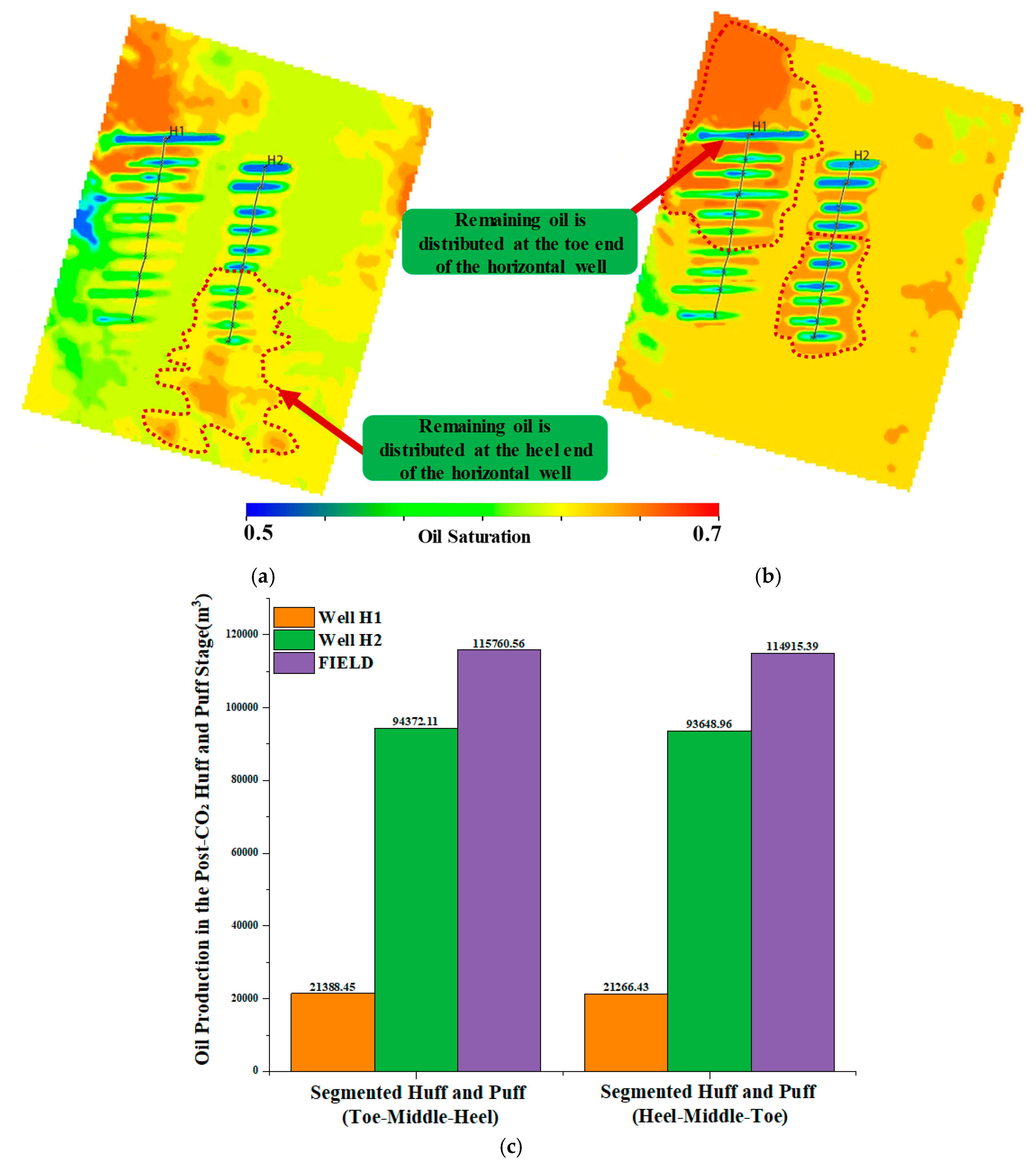
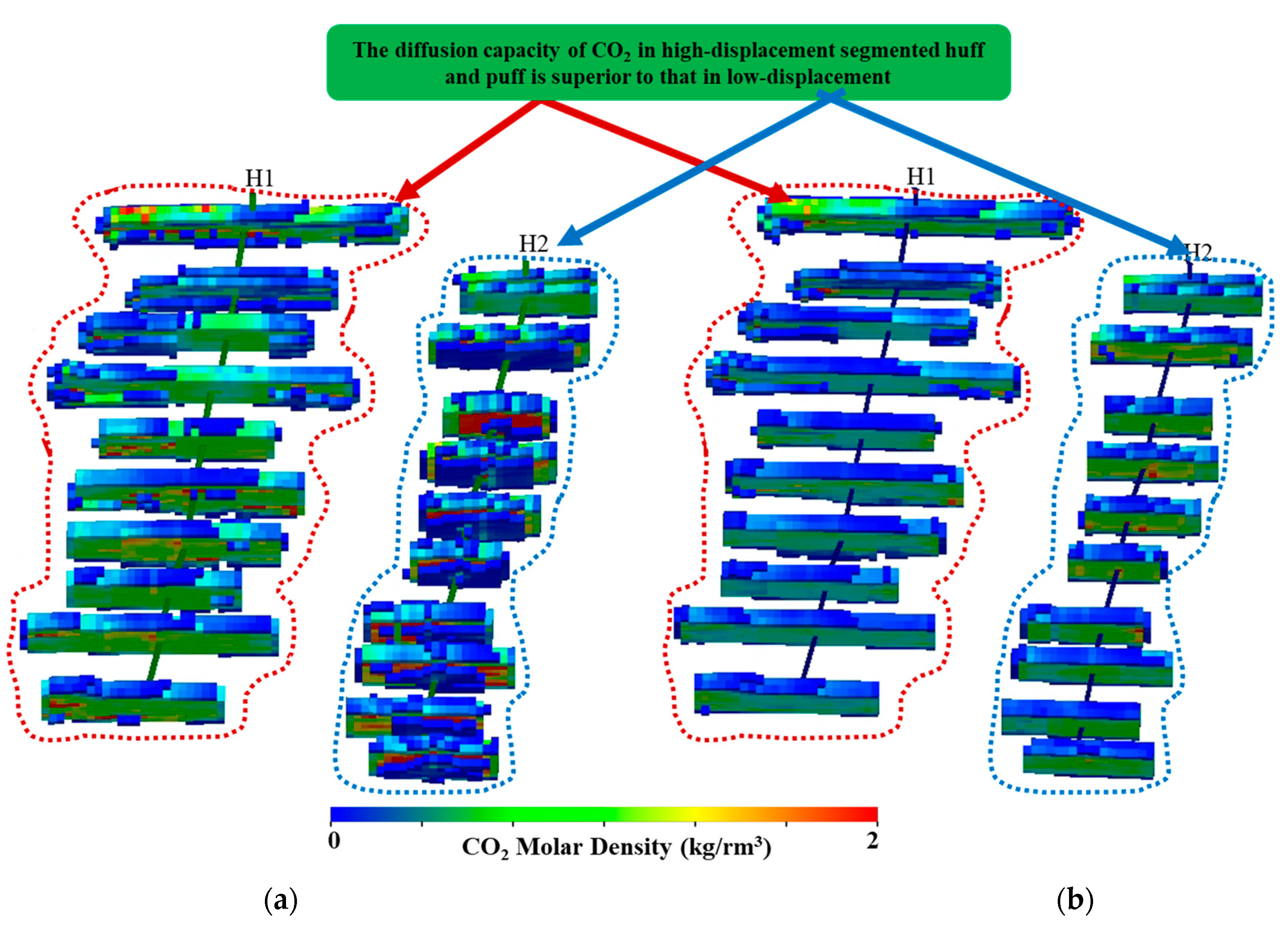


| No. | Scheme Name | Key Parameter Settings |
|---|---|---|
| 1 | Low-Rate Generalized CO2 Huff-and-Puff | Injection rate set to 0.1 m3/min, with CO2 injected uniformly along the entire horizontal well section. |
| 2 | Low-Rate Segmented CO2 Huff-and-Puff (Heel–Mid–Toe) | Injection rate set to 0.1 m3/min; CO2 is injected in segments following the sequence: heel first, then mid-section, and finally toe. |
| 3 | Low-Rate Segmented CO2 Huff-and-Puff (Toe–Mid–Heel) | Injection rate set to 0.1 m3/min; CO2 is injected in segments following the sequence: toe first, then mid-section, and finally heel. |
| 4 | High-Rate Generalized CO2 Huff-and-Puff | Injection rate set to 6 m3/min, with CO2 injected uniformly along the entire horizontal well section. |
| 5 | High-Rate Segmented CO2 Huff-and-Puff (Heel–Mid–Toe) | Injection rate set to 6 m3/min; CO2 is injected in segments following the sequence: heel first, then mid-section, and finally toe. |
| 6 | High-Rate Segmented CO2 Huff-and-Puff (Toe–Mid–Heel) | Injection rate set to 6 m3/min, with a segmented huff-and-puff sequence injected first at the toe, then the middle, and finally the heel. |
| Grid Data | Rock Data | Fluid Property | Initial Model Data | Initial Model Data |
|---|---|---|---|---|
| Number of grid blocks: 958,816 | Average formation pressure: 17.5 MPa | Average crude oil viscosity: 1.59 mPa·s | Average crude oil viscosity: 1.59 mPa·s | C1: 9.5% |
| Grid size: 20 m × 20 m in X/Y directions; average 1 m in Z direction | C2–C6 31.3% | |||
| Average permeability: 0.45 mD | Rock compressibility: 1.5 × 10−5 MPa−1 | Average crude oil viscosity: 1.59 mPa·s | Initial oil saturation: 0.65 | C7–C15 21.1% |
| Average porosity: 0.11 | C16+: 18.1% |
| No. | Scheme Name | Cumulative Oil Production After 5 Years (m3) | Water Cut (%) | Increment in Recovery Factor (%) | Increment in Recovery Factor (t/t) |
|---|---|---|---|---|---|
| 1 | Depletion Development | 33,095.99 | 16.9% | / | / |
| 2 | Low-Rate Generalized CO2 Huff-and-Puff | 21,083.9 | 14.34% | / | / |
| 3 | Low-Rate Segmented CO2 Huff-and-Puff (Heel–Mid–Toe) | 36,827.58 | 12.17% | 0.34% | 0.08 |
| 4 | Low-Rate Segmented CO2 Huff-and-Puff (Toe–Mid–Heel) | 37,301.96 | 12% | 0.38% | 0.09 |
| 5 | High-Rate Generalized CO2 Huff-and-Puff | 46,151.82 | 11.18% | 1.19% | 0.29 |
| 6 | High-Rate Segmented CO2 Huff-and-Puff (Heel–Mid–Toe) | 114,915.39 | 7.26% | 7.44% | 1.80 |
| 7 | High-Rate Segmented CO2 Huff-and-Puff (Toe–Mid–Heel) | 115,760.56 | 7.13% | 7.51% | 1.82 |
Disclaimer/Publisher’s Note: The statements, opinions and data contained in all publications are solely those of the individual author(s) and contributor(s) and not of MDPI and/or the editor(s). MDPI and/or the editor(s) disclaim responsibility for any injury to people or property resulting from any ideas, methods, instructions or products referred to in the content. |
© 2025 by the authors. Licensee MDPI, Basel, Switzerland. This article is an open access article distributed under the terms and conditions of the Creative Commons Attribution (CC BY) license (https://creativecommons.org/licenses/by/4.0/).
Share and Cite
Qi, S.; Yu, J.; Li, J.; Liu, X.; Yu, S.; Chen, Q.; Wu, M. Enhancing CO2 Sweep Efficiency in Tight Reservoir Horizontal Wells: A Segmented Huff-and-Puff Strategy to Mitigate Heterogeneity Effects. Processes 2025, 13, 3706. https://doi.org/10.3390/pr13113706
Qi S, Yu J, Li J, Liu X, Yu S, Chen Q, Wu M. Enhancing CO2 Sweep Efficiency in Tight Reservoir Horizontal Wells: A Segmented Huff-and-Puff Strategy to Mitigate Heterogeneity Effects. Processes. 2025; 13(11):3706. https://doi.org/10.3390/pr13113706
Chicago/Turabian StyleQi, Songchao, Jiuzheng Yu, Jianshan Li, Xiaochun Liu, Shichun Yu, Qianyi Chen, and Manwen Wu. 2025. "Enhancing CO2 Sweep Efficiency in Tight Reservoir Horizontal Wells: A Segmented Huff-and-Puff Strategy to Mitigate Heterogeneity Effects" Processes 13, no. 11: 3706. https://doi.org/10.3390/pr13113706
APA StyleQi, S., Yu, J., Li, J., Liu, X., Yu, S., Chen, Q., & Wu, M. (2025). Enhancing CO2 Sweep Efficiency in Tight Reservoir Horizontal Wells: A Segmented Huff-and-Puff Strategy to Mitigate Heterogeneity Effects. Processes, 13(11), 3706. https://doi.org/10.3390/pr13113706







